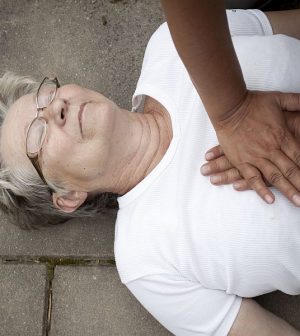- Navigating Your Midlife Crisis: Embracing New Possibilities
- City Raccoons Showing Signs of Domestication
- Mapping the Exposome: Science Broadens Focus to Environmental Disease Triggers
- One Week Less on Social Media Linked to Better Mental Health
- Your Brain Changes in Stages as You Age, Study Finds
- Some Suicide Victims Show No Typical Warning Signs, Study Finds
- ByHeart Formula Faces Lawsuits After Babies Sickened With Botulism
- Switch to Vegan Diet Could Cut Your Greenhouse Gas Emissions in Half
- Regular Bedtime Does Wonders for Blood Pressure
- Dining Alone Could Mean Worse Nutrition for Seniors
Bystanders Key to Cutting Cardiac Arrest Deaths

Cardiac arrest outside of a hospital setting is a leading cause of disease-related health loss in the United States, a new study says.
But bystander use of CPR and automated external defibrillators reduces the risk of death and disability.
“Cardiac arrest is unique because survival is dependent on the timely response of bystanders, medical dispatch, EMS personnel, physicians and hospital staff,” said lead author Dr. Ryan Coute, a resident in emergency medicine at the University of Alabama at Birmingham.
Coute said people need to know that “cardiac arrest” and “heart attack” are not the same.
Cardiac arrest, an abrupt loss of the heart’s ability to pump, leads to death within minutes if not treated. A heart attack happens when blood flow to the heart is blocked.
Researchers analyzed nearly 60,000 cardiac arrest cases that occurred outside a hospital setting in 2016. Their aim was to find out the years of life lost prematurely along with years lived with disability due to a disease.
That’s a rate known as disability-adjusted life years, or DALY.
In 2016, the DALY for out-of-hospital cardiac arrest stood at 1,347 per 100,000 people. That made it the nation’s third-leading cause of health loss due to disease, behind ischemic heart disease (2,447) and low back and neck pain (1,565).
People who suffered an out-of-hospital cardiac arrest lost an average of 20.1 healthy years. Nationwide, this translated to 4.3 million healthy life years lost in the United States.
Women had higher DALY rates than men. Hispanics had higher rates than whites, who had higher rates than blacks, the study found.
Researchers also looked at how bystanders’ use of CPR and automated external defibrillators (AED) factored in.
They found that survival to hospital discharge was higher for cardiac arrest patients who received bystander CPR than for those who did not (21.5 percent vs. 12.9 percent).
The study was published March 12 in the journal Circulation: Cardiovascular Quality and Outcomes.
The impact of cardiac arrest on years lost to premature death and disability was previously unknown.
“Our results show that bystander interventions reduce death and disability, underscoring the importance of bystander CPR and AED education, as well as national cardiac arrest surveillance,” Coute said in a journal news release.
“Our results may also help inform funding agencies and policy makers regarding how to best utilize limited resources to improve public health,” he added.
More information
The American Heart Association has more on cardiac arrest.
Source: HealthDay
Copyright © 2025 HealthDay. All rights reserved.










